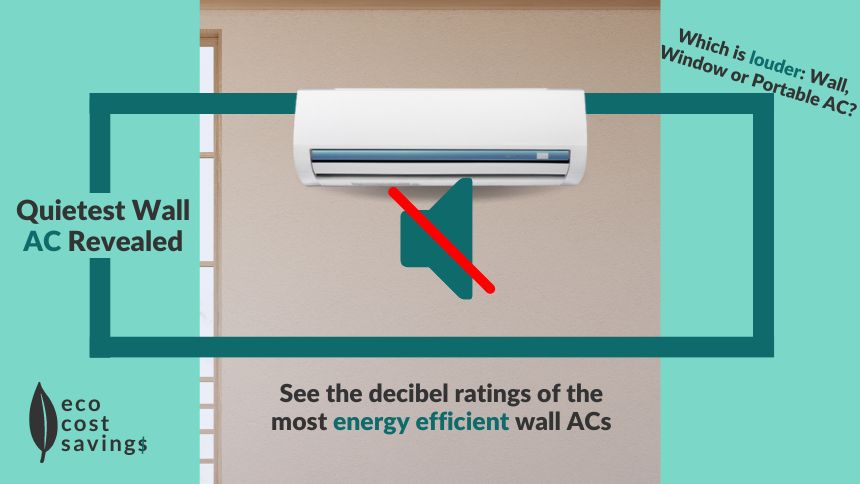Last updated: February 24, 2024.
Which is the quietest through-the-wall air conditioner? Find out below, based on a comprehensive study (updated for 2024). Plus, see the average & most common decibel ratings, and see how loud the most efficient wall ACs are.
The noise level of a wall air conditioner is a very important consideration. Each 10 point increase in decibels is perceived by humans as twice as loud, according to the Hearing Health Foundation.
Results from this study shows that, in terms of human perceived difference, the loudest wall air conditioner is nearly 4 times as loud as the quietest unit.
In this article you’ll find results from a comprehensive study of wall air conditioner noise levels (includes data from models released up to and including 2024).
Spoilers:
- The quietest wall air conditioner is the 52 dB Impecca ITAC08-KS21;
- The most common wall AC noise level is 61 dB, with the average being 59.7 dB;
- Wall AC noise levels typically range from 56 dB to 65 dB, but outliers can reach a quiet 52 dB to a loud 69 dB;
- Wall air conditioners are louder than window and portable units, on average; and
- For perspective, wall ACs create noise levels that are equivalent to background music.
Continue reading to see the decibel ratings of the most energy efficient wall air conditioners by room size.

Quietest wall air conditioner
The quietest wall air conditioner is the Impecca ITAC08-KS21, with a decibel rating of just 52 dB.
This low noise wall air conditioner has a decibel rating that is nearly 13% lower than the average for wall ACs, and is close to 15% quieter than the most common wall unit noise rating.
See the specs and price of the quietest wall AC, here.
This low noise wall air conditioner caters to rooms up to 350 sq. ft., and is also ENERGY STAR certified.
Continue reading to see how loud the most energy efficient wall air conditioners are. But first, let’s take a look at the noise level results from the study.
Wall air conditioner noise levels
Wall air conditioner noise levels typically range from 56 dB to 65 dB.
However, there are outliers that can be a quiet 52 dB to a loud 69 dB.
The most common wall air conditioner noise level is 61 dB, with the average being 59.7 dB.
Wall air conditioner units, also referred to as through-the-wall air conditioners, produce different noise levels depending on the unit’s settings (e.g. desired temperature & fan speed) and surrounding conditions (e.g. general room temperature & if there’s a heat source nearby).
The more work the unit needs to do, the louder it will be.
The noise level figures used in the study are based on the manufacturer’s listed decibel ratings.
These predominantly refer to the noise produced in the quietest mode under typical operating conditions or the max expected sound level.
So, make sure to check the unit’s specifications to see if the minimum or maximum noise levels are being listed.
There’s an additional noise level consideration worth noting.
A wall AC unit is typically louder outdoors than it is indoors.
Using a sound level meter, you’ll generally find that the same unit produces different decibel levels outside compared to inside.
Through-the-wall air conditioners are approx. 5 dB to 10 dB louder outside.
But, given the ambient noise outside, this is usually not an issue.
So, now that we know how loud wall ACs typically are, let’s briefly take a look at the decibel ratings of quiet through-the-wall air conditioners.
Quiet wall air conditioner units
Quiet wall air conditioners have a noise level that is 56 dB or less.
The loudest through-the-wall ACs produce 65 dB or more, with the average range falling in between.
The cooling capacity of quiet wall ACs can reach as high as 9,800 BTU. However, 8,000 BTU is most common.
So how does this convert to recommended room sizes?
Quiet wall ACs typically cater to rooms that are 350 sq. ft. or less.
One outlier to this is the LG LT1037HNR, which cools rooms up to 450 sq. ft.
But it’s a lot more common for quiet wall ACs to cater to rooms up to 350 sq. ft.
For example, the quietest through-the-wall air conditioner, mentioned above, caters to rooms up to this size.
In case you missed it, here’s the link to this 52 dB low noise wall AC unit: check it out Amazon, here (and here’s another link to the unit on Home Depot, which lists the specs more clearly).
Larger rooms require more powerful units, which are generally louder.
However, there are loud wall ACs that only cater to small rooms. These appear, after a brief spotcheck, to be units that are less energy efficient.
Speaking of energy efficiency, let’s take a look at the noise levels of the most energy efficient wall ACs by room size.
Noise levels of the most energy efficient wall ACs
The most energy efficient wall ACs have noise levels that range from 56 dB to 59 dB indoors, and 62 dB to 65 dB outdoors.
Based on a 2024 study of over 251 units, the table below lists the most energy efficient wall air conditioners by room size, along with their decibel ratings. Also included are links to the relevant unit for more details.
| Room size | Most efficient wall AC | Link for more details | Noise level indoors | Noise level outdoors |
| 250 sq. ft. | GE – AJCQ06LWH (6,000 BTU) | See product, here. | Not available | Not available |
| 300 to 350 sq. ft. | LG – LT0816CER (8,000 BTU) | Check it out, here. | 56 dB | 62 dB |
| 400 to 450 sq. ft. | LG – LT1016CER (9,800 BTU) | See price, here. | 56 dB | 65 dB |
| 500 to 550 sq. ft. | LG – LT1236CER (208V, 11,500 BTU) | Get details, here. | 59 dB | 65 dB |
| 600+ sq. ft. | Friedrich – WCT16A30A (230V, 15,400 BTU) | Check it out, here. | Not available | Not available |
Unfortunately, not all manufacturers have decibel ratings listed on their spec sheets.
For more information on the study, and wall AC energy efficiency in general, check out Wall AC Efficiency Results.
Related: Most energy efficient portable air conditioner, and Most efficient wall AC unit.
So, now we know how much noise wall ACs make and how loud the most energy efficient units are, but is it a lot?
Let’s put the sound levels into perspective.
Are wall air conditioners loud? And how do they compare with window & portable units?
Wall air conditioners are not loud, but they are louder than window and portable ACs, on average.
Wall ACs are 5.1 dB louder than portable units, and 3.3 dB louder than window units, on average.
The most common decibel rating for wall air conditioners (i.e. 61 dB) is 5 dB louder than the most common for window and portable ACs (i.e. 56 dB).
So wall air conditioners are louder than their window and portable counterparts.
For more details, check out this article comparing all air conditioner decibel ratings.
But are wall air conditioners considered loud?
This is a subjective question, so bear with me for a moment.
Wall air conditioners have a noise level that is similar to background music, which is considered to be 60 dB – anything at or below 70 dB is safe, according to Hearing Health Foundation.
You may consider background music loud at night when you’re trying to sleep. But this may be a different story during the day, when you’re outside for example.
To remove subjectivity, let’s say noise levels that are above the safe range are loud.
In this case, wall air conditioners are not loud.
Don’t miss
The difference between the quietest wall AC and those that have high decibel ratings is substantial.
They can be perceived as over twice to nearly 4 times as loud as the quietest unit.
I hope that the insights from this study helps you benchmark wall AC decibel ratings, and ultimately stay cool in peace.
And I hope that, by listing the decibel ratings of the most energy efficient wall ACs, you might consider or find a unit that meets your noise level requirements in a manner that also reduces your electricity bills and carbon footprint (even if just slightly).
You may also be interested in more details about wall AC energy efficiency, so don’t miss Wall AC Energy Efficiency Results [Wall AC Vs Window AC].
For insights into the noise levels of wall AC counterparts (including how to reduce their noise levels), check out:
- Are Portable Air Conditioners Quiet? [Quietest Revealed | 13 Noise Reducing Tips];
- Quietest Window Air Conditioner [1,037 Studied | 11 Noise Reducing Tips]; and
- Quiet Air Conditioner: The Ultimate Study [1,323+ ACs].
If you’d like to quickly make more substantial savings on your electricity bills and carbon footprint, don’t miss this 6 Quick Wins Cheat Sheet:
-
Highest SEER Heat Pump Revealed [2,126 Units Studied]
What is a good SEER rating for a heat pump, & what’s the highest? Find out here, based on a comprehensive study of 2,126 of the most energy efficient heat pumps.
-
Quietest Wall AC Revealed [2024 Noise Level Study Results]
Which is the quietest through-the-wall air conditioner? Find out here, based on a comprehensive study. Plus, see the average & most common decibel ratings, and see how loud the most efficient wall ACs are.
-
Wall AC Efficiency Results 2024 [Incl. Wall AC vs Window AC]
See the most efficient wall AC unit, energy efficient wall air conditioners by room size, & get insights into wall AC wattage, amperage, running costs & BTU. Plus, see how wall & window ACs compare.
James, Eco Cost Savings co-founder and Editor-in-Chief, is also our experienced in-house energy management and sustainability expert, and manager of our network of sustainability consultants.
Before his journey into sustainability, James studied engineering. Additionally, he has experience in HVAC installation, and data analysis. A self-proclaimed practical environmentalist, and avid penny pincher, James established Eco Cost Savings to share his and his colleague’s expertise with the aim of helping to reduce energy bills and carbon footprints at scale.


![Highest SEER Heat Pump Revealed [2,126 Units Studied]](https://ecocostsavings.com/wp-content/uploads/2022/10/highest-seer-heat-pump.jpg)
![Wall AC Efficiency Results 2024 [Incl. Wall AC vs Window AC]](https://ecocostsavings.com/wp-content/uploads/2022/07/wall-ac-vs-window-ac.jpg)